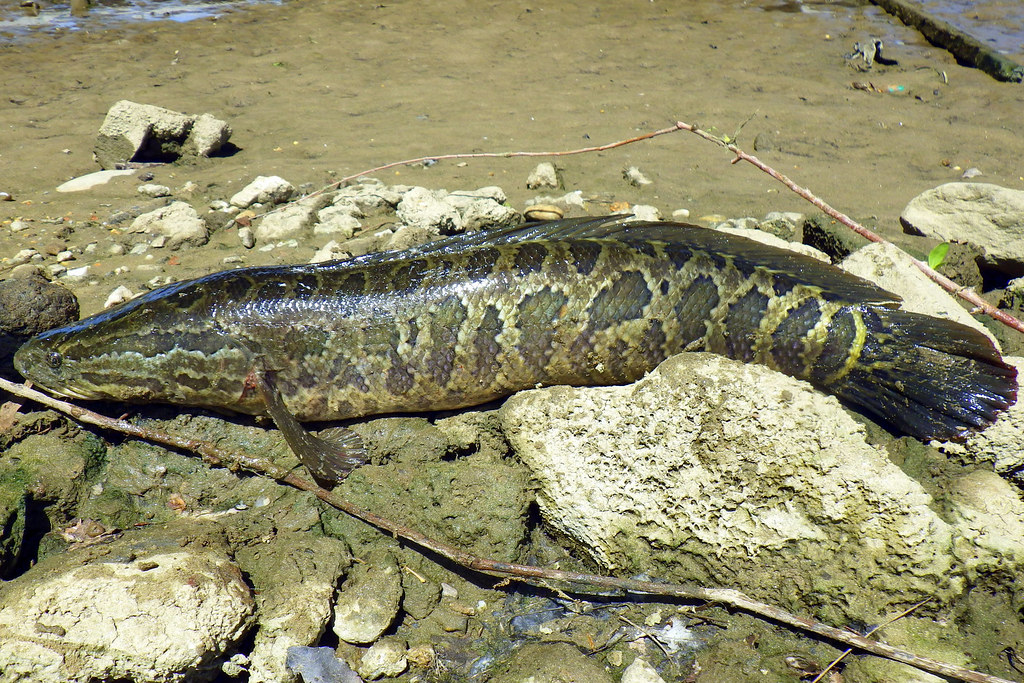Chesapeake Channa
Channa argus
The Chesapeake channa (formerly known as the Northern snakehead) is a large, long fish with a mottled, snake-like pattern. It is an invasive species that can be found in Maryland and Virginia.
This section shows one large critter image at a time. Use the thumbnails that follow to select a specific image to display here.

This gallery contains a grid of small thumbnails. Selecting a thumbnail will change the main image in the preceding section.
Appearance
The Chesapeake channa's elongated body grows to 33 inches in length. It has tan, dark brown or black coloring with a mottled, snake-like pattern. Its long dorsal fin runs along most of its back. It has a large mouth with a protruding lower jaw and many teeth. Young may be golden brown or pale gray, darkening as they grow older.
Feeding
Chesapeake channas prefer to eat fish, but will also feed on frogs, crustaceans and small birds, mammals or reptiles. Once a snakehead is fully mature, other fish will make up over 90% of their diet, such as largemouth bass and white perch. The fish typically feed in schools and prefer to hunt their prey in areas of low light.
Predators
While the Chesapeake channa has no natural predators in the Chesapeake Bay watershed, young have been reported being carried away by large birds of prey, such as ospreys and eagles. However, once they have fully matured, northern snakeheads are not prone to predation.
Reproduction and life cycle
Females reach sexual maturity at two years old and can lay as many as 15,000 eggs one to five times per year. The eggs will hatch in one to two days. Larvae remain in the nest, which both parents guard. Larvae are nourished by a yolk that they absorb by the time they are less than one-third of an inch long.
After that, they feed mostly on insects, small crustaceans and fish larvae. Chesapeake channa are highly resilient to changes in salinity, temperature and diet, and can live out of water for up to four days. They will also lie dormant in mud during droughts. On average, the Chesapeake channa lives eight years in the wild.
Did you know?
-
The Chesapeake channa is able to breathe air from the atmosphere using an air bladder that works similar to a lung.
-
It was first discovered in the Bay watershed in a pond in Crofton, Maryland, in 2002.
-
Chesapeake channa regulations vary from state to state and are as follows:
-
Delaware: It is illegal to transport, purchase, sell, stock or possess live Chesapeake channa in Delaware. Anyone who catches a Chesapeake channa is encouraged to kill it and notify the Division of Fish and WIldlife by calling (302) 735-8653 or (302) 739-9914.
-
Maryland: It is illegal to possess, import or transport live Chesapeake channa. If you catch and want to keep a Chesapeake channa in Maryland, you are required to kill it. If you have any further questions about catching or harvesting snakeheads, please contact the Maryland Department of Natural Resources by calling (410) 260-8300.
-
Pennsylvania: Anglers who catch a Chesapeake channa are encouraged not to release it. It is illegal to introduce or import Chesapeake channa into Pennsylvania waters, or to possess live fish. If you catch a Chesapeake channa in Pennsylvania, please contact the Fish and Boat Commission at (610) 847-2442 or via email using this contact form.
-
Virginia: It is illegal to possess, import or transport live Chesapeake channa. The Department of Game and Inland Fisheries asks that all Chesapeake channa be killed if possible. Any fish in someone's possession must be dead.
-
Sources and additional information
- Fish Facts: Northern Snakehead – Maryland Department of Natural Resources
- Northern Snakehead – Pennsylvania Fish and Boat Commission
- Nonindigenous Aquatic Species: Northern Snakehead – U.S. Geological Survey
- Northern Snakehead – Virginia Department of Game and Inland Fisheries
